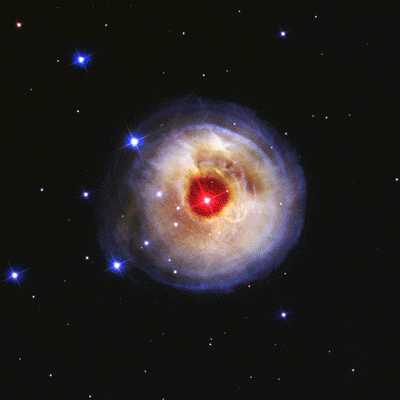Io moves across the face of Jupiter
While hunting for volcanic plumes on Io, the NASA/ESA Hubble Space Telescope captured this image of the volatile moon sweeping across the face of Jupiter.
The moon Io casts a shadow on the vast clouds of gas which get constantly churned up and rotate around the giant planet in huge weather systems.
Jupiter's immense, complex atmosphere bristles with lightning and swirls with violent storms, including the Great Red Spot, a storm that has lasted perhaps as long as 300 years. The reddish colour of the Great Red Spot is a puzzle to scientists, but it is thought that several chemicals, including phosphorus, could be the cause.
Some scientists think that beneath the atmosphere there is no solid mass at the center of Jupiter, but that the planet's unique temperature and pressure conditions produce a core with a density more like a liquid or ice slush.
Jupiter is the largest of our nine planets, containing two-thirds of the planetary mass of our Solar System. In composition it resembles a small star, with helium and hydrogen as the main gases. Its interior pressure may reach 100 million times the pressure on Earth's surface.
Jupiter's magnetic field is immense, even in proportion to the size of the planet, stretching millions of miles into the solar system. It has 16 major moons, including Io, and a ring system.
The Hubble Space Telescope (HST) is a collaboration between ESA and NASA. It is a long-term, space-based observatory. The observations are carried out in visible, infrared and ultraviolet light. In many ways Hubble has revolutionised modern astronomy, not only by being an efficient tool for making new discoveries, but also by driving astronomical research in general.















 Germany
Germany
 Austria
Austria
 Belgium
Belgium
 Denmark
Denmark
 Spain
Spain
 Estonia
Estonia
 Finland
Finland
 France
France
 Greece
Greece
 Hungary
Hungary
 Ireland
Ireland
 Italy
Italy
 Luxembourg
Luxembourg
 Norway
Norway
 The Netherlands
The Netherlands
 Poland
Poland
 Portugal
Portugal
 Czechia
Czechia
 Romania
Romania
 United Kingdom
United Kingdom
 Slovenia
Slovenia
 Sweden
Sweden
 Switzerland
Switzerland






























